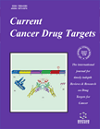- Home
- A-Z Publications
- Current Cancer Drug Targets
- Previous Issues
- Volume 8, Issue 2, 2008
Current Cancer Drug Targets - Volume 8, Issue 2, 2008
Volume 8, Issue 2, 2008
-
-
Editorial [ Apoptotic Pathways as Targets for Therapeutic Intervention Guest Editor: Domagoj Vucic ]
More LessThe evolutionarily conserved process of apoptosis plays an important role in removing cells during development and in maintaining tissue homeostasis. However, dysregulation of apoptosis, leading to too much or too little cell death, contributes to a number of diseases including cancer. Designing anti-cancer therapeutic solutions requires the understanding of the interplay between positive and negative regulators of the Read More
-
-
-
p53: A Guide to Apoptosis
More LessAuthors: Erik Meulmeester and Aart G. JochemsenApproximately 50% of sporadic human tumors harbor somatic mutations in the p53 gene locus, while germ line mutations confer a high familial risk and are associated with Li-Fraumeni Syndrome patients. The p53 tumor suppressor protein is often referred to as the “guardian of the genome” since its response to DNA-damage or checkpoint failure gives rise to a series of anti-proliferative responses. One of the most i Read More
-
-
-
Targeting Cell Death in Tumors by Activating Caspases
More LessAuthors: A. C. Clark and Sarah H. MacKenzieCytotoxic approaches to killing tumor cells, such as chemotherapeutic agents, γ-irradiation, suicide genes or immunotherapy, have been shown to induce cell death through apoptosis. The intrinsic apoptotic pathway is activated following treatment with cytotoxic drugs, and these reactions ultimately lead to the activation of caspases, which promote cell death in tumor cells. In addition, activation of the extrinsic apoptotic pa Read More
-
-
-
Targeting IAP (Inhibitor of Apoptosis) Proteins for Therapeutic Intervention in Tumors
More LessApoptosis, or programmed cell death, is a cell suicide process with a major role in development and homeostasis in vertebrates and invertebrates. Dysregulation of apoptosis leading to early cell death or the absence of normal cell death contributes to a number of disease conditions including neurodegenerative diseases and cancer. Inhibition of apoptosis enhances the survival of cancer cells and facilitates their escape from i Read More
-
-
-
Ubiquitylation and Cancer Development
More LessAuthors: John Silke, Maria Miasari and Hamsa PuthalakathUbiquitylation is an essential cellular process, and yet many cancer cells appear to be more reliant upon it than normal cells as they are surprisingly sensitive to proteasome inhibitors (PI) and proteasome inhibitor drugs are well tolerated in vivo. Several reviews have suggested that specific protein targets account for PI induced cell death, but fail to adequately explain why cancer cells are more sensitive than normal cells to Read More
-
-
-
Tumor Necrosis Factor: Renaissance as a Cancer Therapeutic?
More LessAuthors: D. Daniel and N. S. WilsonSince the discovery of tumor necrosis factor (TNF)-alpha, researchers have pursued many approaches to harness the potency of TNF-alpha and TNF superfamily members to treat human cancers. Several ligands of the TNF superfamily, including TNF-alpha, lymphotoxin, FAS ligand (FasL), and APO2 ligand/TNF-related apoptosis-inducing ligand (Apo2L/TRAIL) have been tested in various stages of clinical research for their anti-tu Read More
-
-
-
Modulation of TRAIL-Induced Apoptosis by HDAC Inhibitors
More LessBy Simone FuldaTriggering apoptosis, the cell's intrinsic death program, is a promising approach for cancer therapy. TNF-related apoptosisinducing ligand (TRAIL), a member of the TNF superfamily of death inducing ligands, is of special interest for cancer therapy, since TRAIL has been shown to predominantly kill cancer cells, while sparing normal cells. However, since many cancers fail to undergo apoptosis in response to TRAIL treatment, TRAI Read More
-
-
-
Application of Proteome Analysis to the Assessment of Prognosis and Response Prediction in Clinical Oncology
More LessAuthors: Christoph Rocken, Ralf Ketterlinus and Matthias P.A. EbertIn Europe more than 3 million individuals develop a malignancy annually. Despite recent progress in screening, diagnosis and therapy of most cancers, prognosis remains poor and only a minority of patients are cured. This owes to the fact that most cancers are diagnosed in advanced stages and due to the fact that treatment options for most cancers are limited. While there has been a substantial improvement in syste Read More
-
-
-
Natural and Synthetic Agents Targeting Inflammation and Angiogenesis for Chemoprevention of Prostate Cancer
More LessProstate cancer is the most common cancer in men and one of the leading causes of cancer-related deaths in Western countries. The extraordinary biological heterogeneity, the increasing incidence of this disease, and the presence of putative premalignant conditions make prostate cancer a crucial pathology to study and test pharmacological or nutritional chemopreventive strategies. It has been demonstra Read More
-
-
-
Novel Monoclonal Antibodies for the Treatment of Chronic Lymphocytic Leukemia
More LessFor many years, alkylating agents and purine nucleoside analogs (PNA) have been considered the drug of choice for treatment of chronic lymphocytic leukemia (CLL). More recently the introduction of monoclonal antibodies (mAb), especially rituximab directed against CD20 and alemtuzumab directed against CD52, has renewed interest in CLL therapy. Over the last few years, several new mAbs directed against ly Read More
-
Volumes & issues
-
Volume 25 (2025)
-
Volume 24 (2024)
-
Volume 23 (2023)
-
Volume 22 (2022)
-
Volume 21 (2021)
-
Volume 20 (2020)
-
Volume 19 (2019)
-
Volume 18 (2018)
-
Volume 17 (2017)
-
Volume 16 (2016)
-
Volume 15 (2015)
-
Volume 14 (2014)
-
Volume 13 (2013)
-
Volume 12 (2012)
-
Volume 11 (2011)
-
Volume 10 (2010)
-
Volume 9 (2009)
-
Volume 8 (2008)
-
Volume 7 (2007)
-
Volume 6 (2006)
-
Volume 5 (2005)
-
Volume 4 (2004)
-
Volume 3 (2003)
-
Volume 2 (2002)
-
Volume 1 (2001)
Most Read This Month
Article
content/journals/ccdt
Journal
10
5
false
en


